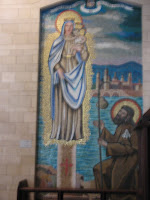




On Tuesday, October 28
th, I picked up our rental car in
Be'er Sheva and we headed for
Tiberias. It was after 11:30 am when we left
Be'er Sheva. Dawn's supervisor had told her there were 2 options to get to
Tiberias after leaving Tel
Aviv, one way by going part way up the coast and cutting across on a diagonal to Nazareth, and one by staying on the expressway along the Mediterranean as far as Haifa, and then going east to Nazareth from Haifa. We chose to go through Haifa, which was a mistake, because the expressway turned into the main street through Haifa (not apparent from the map) and became a very slow affair. By the time we got to Nazareth, I just wanted to find our hotel in
Tiberias and save the Church of the Annunciation for our return trip to
Be'er Sheva on Thursday. This, in fact, is what we did, although we did drive past the church going through town. Nazareth is not built for the amount of tourist traffic it has, which made it almost as stressful as Tel
Aviv during Rush Hour on Thursday. (In fairness, I did not think about Rush Hour when we left Nazareth Thursday at 2 pm, because I wanted to find our way through Tel
Aviv before it got dark at 5 pm). I think I'll choose the darkness next time.
In any case, we found our hotel, the Berger, in
Tiberias, just before it was completely dark on Tuesday. The owner of the hotel showed us to a large room with a balcony on the 3rd (top) floor of the hotel. This is a budget hotel recommendation of
Frommer's and we recommend it to anyone not wishing to spend $300 per night at the hotels on the shore of the Sea of Galilee, or the Waterfront Promenade, as it is called in
Tiberias. We paid 250
NIS per night, including breakfast (about $65 per night). The owner said the best restaurants were a 15-20 minute walk down to the waterfront, but as we were tired, he recommended a very good pizza place 2 blocks from the hotel. It was great, as cheese, milk, and dairy products are expensive here, and we seem to crave cheese and milk. When I get back to the U.S., I'm going to have lots of milk and ice cream!
On Wednesday, we drove around the circumference of the Sea of Galilee beginning in the north, stopping at the Mt. of Beatitudes, where Jesus preached the Sermon on the Mount, first. It was very beautiful, but filled with tourists, especially Germans. We kept pace with a German tour group throughout the first part of our day, and I was able to listen in once in a while. Prices at the gift shop were in U.S. dollars, and they gave us a poor exchange rate for our
schekels. I had some dollars in
Be'er Sheva, but who knew I would need them in Israel?
Recommendation: Buy only a couple postcards here. Souvenirs are cheapest at Taghba (Church of the Loaves and Fishes Miracle). The mosaics at the Church of the Loaves and Fishes are really cool. After stopping there, we drove to
Capernaum, where Peter lived, and Jesus attended synagogue there. The church in
Capernaum has seating in the round, with a glass floor in the center with the ruins of Peter's house directly below it. Then, we stopped at
Kursi National Park, were Jesus made the demons go into the swine, who then drowned themselves in the Sea of Galilee. Next, we stopped at En
Gev Kibbutz and Fish Restaurant for the famous St. Peter's Fish, caught fresh in the Sea of Galilee. Even though we asked for our fish without the head, Dawn was still turned off by the appearance. (It looked like a fish, with skin and tail). It was expensive (about $20), but the fish and the sides were excellent. Our meal came with
cole slaw, pita bread, and potato or sweet potato. We even had a seat next to the water!
After lunch, we continued driving around the lake after buying yet more postcards. After a brief stop at the Tourist Information on the south side of the Sea, we stopped at Yardenit, where Jesus was baptized by John. For me, this stop was the most spiritually moving of all the stops we made. The water was calm, the trees and the Jordan River were beautiful. The rain had stopped. People were entering the water to bless or baptize themselves with the white, nightgown length T-shirts provided for rent for $10 from the gift shop. We did not rent shirts, but Dawn went in the water up to her ankles, and I dipped my hands in. After leaving, we returned to Tiberias and walked along the Waterfront Promenade just before sunset. Dawn made her way down to the shore to touch the (dirty) waters of the Sea of Galilee.

































